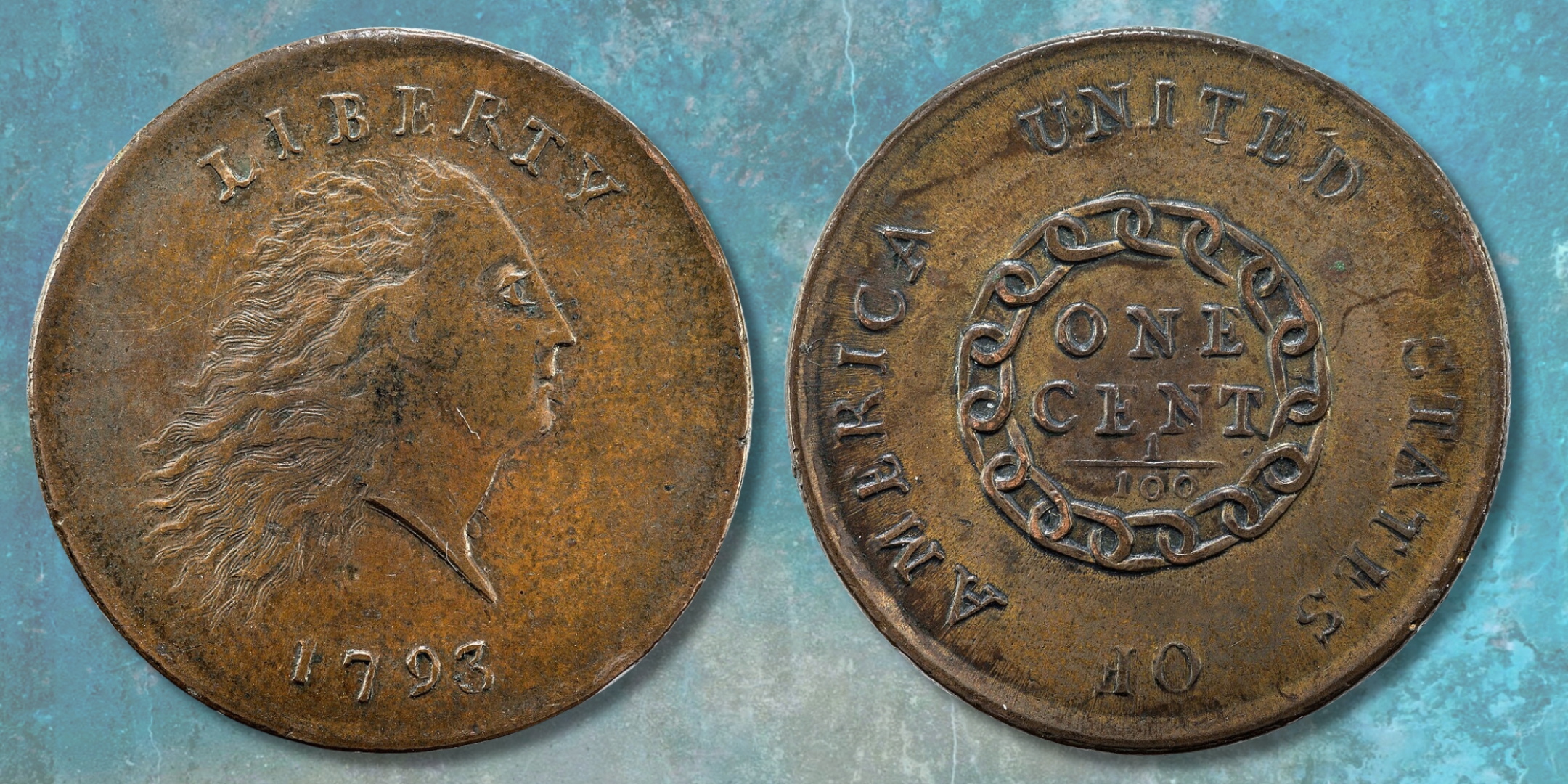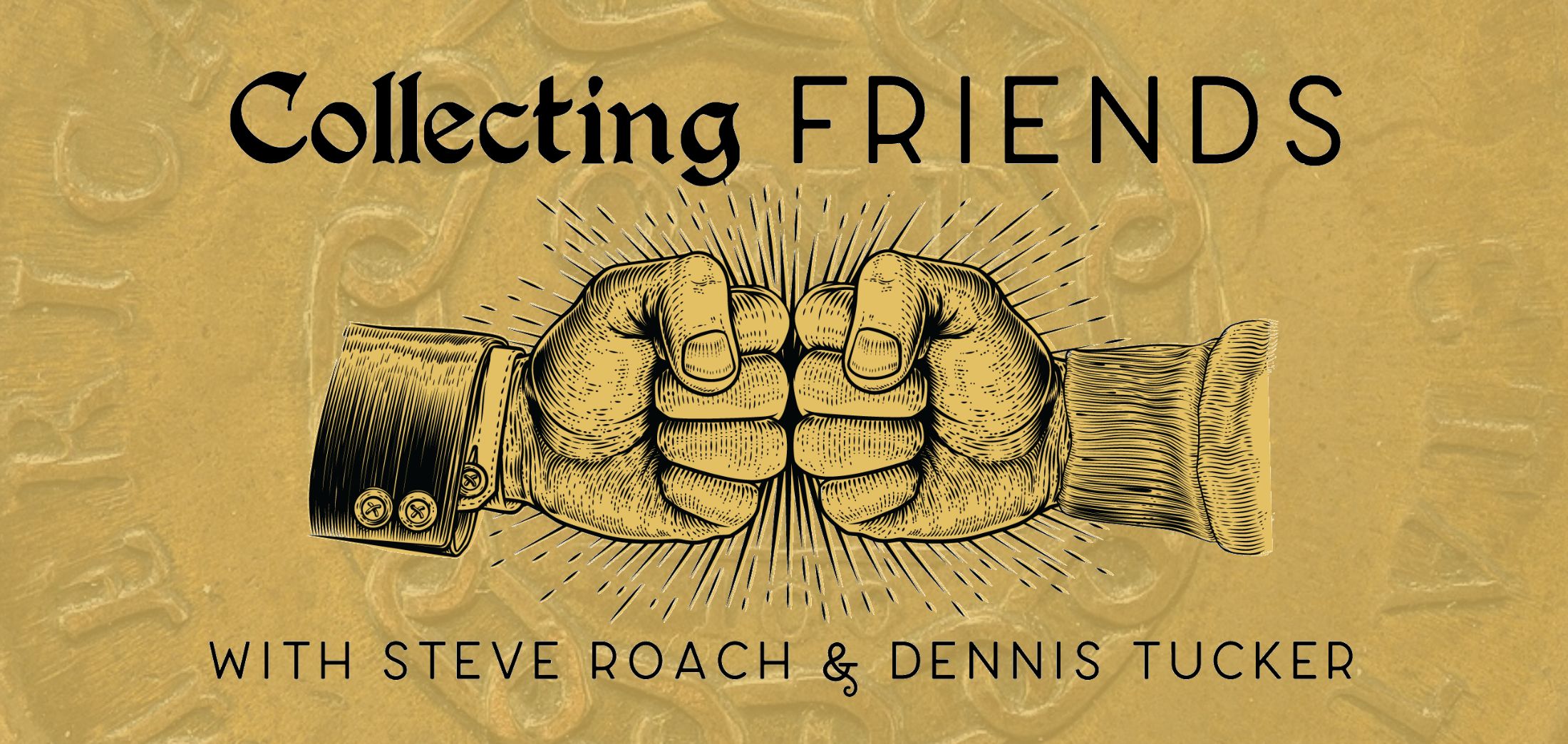Collecting Friends: Is the 1793 Flowing Hair, Chain Large Cent Ugly or Charming?
Is the 1793 Flowing Hair, Chain large cent ugly or charming?
Steve: Dennis and I have discussed design from a few perspectives. The Susan B. Anthony dollar is derided as unattractive by many, but is that because of an expectation that when a woman is depicted on a coin that they should be conventionally attractive for the coin to be considered successful from an aesthetic perspective? How should portraiture necessarily convey a subject’s inner life beyond outward appearances? We’ve looked at the 1951 to 1954 Washington-Carver commemorative half dollar as unsuccessfully combining an anti-Communist message with weak design that does not form a cohesive whole. But what about a coin that is perhaps “ugly” to a non-collector but is charming to collectors who know the history?
For me, that’s the 1793 Flowing Hair, Chain Reverse large cent that was the first coin produced for mass circulation at the Philadelphia Mint. From a technical perspective the coin was successfully adapted to the rigors of long-term circulation as the 13-link chain on the reverse is visible even in the lowest grades and as a one-year type, the date is not necessary to identify it. The chain design is functional, holds up to wear well, and worked within the skill sets of the earliest workers at the U.S. Mint.

The depiction of Liberty is ambitious when compared with the reverse, with a well-modeled face, a hard hairline, and well-articulated strands of hair that again, are crisp on high-grade coins and the overall profile remains legible on low-grade coins.
A March 1876 letter criticizing contemporary coin designs cited by Q. David Bowers in an article in Bowers & Ruddy Galleries, Inc. house publication Rare Coin Review No. 27, Winter 1976-7, saw the letter’s author using the Chain cent as a measuring stick against which they judged the then-circulating Seated Liberty coins, writing “Look at the uninteresting and lifeless Goddess of Liberty with its scared look and shapeless arm… and compare it with the striking and lifeless features of a 1793 Wreath or Chain cent and further comments will be unnecessary.”
Karen Rehder, an educator and student in a class on numismatic writing I taught at the 2016 ANA Summer Seminar pointed out a different perspective on this coin. She shared, “While some folks may take issue with the chain on the reverse, I find the representation of Liberty on the obverse unappealing. First, she’s either depicted with very mannish features or a very weak chin. Second, she’s always having a very bad hair day. Maybe the flowing hair is supposed to represent a release from oppression or a nation in its youth (young girls didn’t bind their hair); however, it misses the mark and makes Liberty seem frenzied. Perhaps her mannish countenance is supposed to represent strength of character and fortitude, but in my opinion, it just makes her look hard. I’m glad that later versions and later designers did a much better job of softening Liberty’s portrait. Liberty should be beautiful because liberty is beautiful.”
Dennis, are you a fan of the “Chain Cent”?
Dennis: With even the most tired-out, worn-smooth, lowest-grade Chain cents selling for thousands of dollars, I wouldn’t kick one out of the ol’ junk box! But it’s hard not to compare this design with what came after . . . and find it lacking. I know that’s unfair, for all the reasons you’ve mentioned—it’s a historic coin, it did its job as a workhorse of American commerce, and it was a good effort for a fledgling mint. But it makes me think of a writer’s rough first drafts, or an artist’s childhood sketches.
Most readers probably don’t know that I’m a used-to-be-professional cartoonist. I remember the very first comic strip I ever had in print, in the venerable Phoenix Register (New York). I was probably eight years old. (I feel a queasy embarrassment even as I delve into this memory!) The strip showed a bloodhound dressed in a suit, waiting for a bus. Yes, a bloodhound; yes, waiting for a bus. Yes, dressed in a suit, and a bowler hat, if I remember correctly. A woman runs up to him and yells, “Mister Smith, Mister Smith, your house is on fire!” The dog panics! He runs down the street, running, running, and then we see the house in the distance, going up in smoke and flames. Suddenly the dog screeches to a halt and says, “Wait a minute! I’m not Mister Smith.”
Please find all surviving copies of that newspaper so I can shred them.
If you’re imagining a well-executed and charming work along the lines of “Calvin and Hobbes” or even “Garfield,” well . . . let’s just say this inauspicious start was my 1793 Chain cent. Unsophisticated, rough-hewn, awkwardly balanced. But I like to think that I got better, just like the Philadelphia Mint’s coins did.
_(obverse).jpg?width=1080&height=1080&name=US-1793-1C-Flowing_Hair_Cent_(chain)_(obverse).jpg)
_(reverse).jpg?width=1080&height=1080&name=US-1793-1C-Flowing_Hair_Cent_(chain)_(reverse).jpg)
Photo Credit: US Mint (coin), National Numismatic Collection (photograph by Jaclyn Nash) - National Numismatic Collection, National Museum of American History
Check back soon for another installment of Collecting Friends or subscribe here and never miss a post! In the meantime, explore beautiful coins from the ANA's Edward C. Rochette Money Museum Virtual Exhibits.
About the Collecting Friends Blog
Hello! And welcome to the ANA’s blog series, “Collecting Friends.”
We decided to approach this much like a conversation between friends. One of us starts with a topic, then the other responds. Simple as that. Along those lines, we’ll keep the tone conversational as much as possible.
We both write about coins professionally, and will keep our relative style guides in our writing. For Dennis, Publisher at Whitman Publishing, that means capitalizing “Proof” and italicizing Red Book and never saying anything bad about Ken Bressett, who’s awesome anyway.
For Steve, who’s written with Coin World for 15 years, it means Winged Liberty Head dime instead of “Mercury” dime, and similar nuances and oddities. And, it means writing A Guide Book of United States Coins (better known as the “Red Book”).
Both of us started collecting when we were little, introduced to coins by a chance encounter with an old coin that sparked our curiosity. One of Steve’s interests is coin valuation, and he gravitates towards the intersection of art and coins. Dennis enjoys medals and world coins, and studying modern U.S. coins in the context of older series, what came before.
We met in 2012 at the American Numismatic Association World’s Fair of Money in Philadelphia at an event hosted by the Austrian Mint where there was both a Ben Franklin and a Betsy Ross impersonator. We’ve become great friends in the past decade. We even were appointed together to sit on the Citizens Coinage Advisory Committee starting in 2016, but Steve resigned soon after he was appointed to accept a full-time job at the Treasury Department while Dennis was re-appointed in 2020.
We taught a course together on numismatic publishing and writing a few years ago at the Summer Seminar, and while life has gotten in the way of us teaching another class, we jumped at our friend Caleb’s suggestion that we write a column. We hope you enjoy it!
.png?width=300&height=300&name=steve%20roach%20circle%20frame%20(2).png)
.png?width=300&height=300&name=dennis%20tucker%20circle%20frame%20(2).png)
About the American Numismatic Association
The American Numismatic Association is a nonprofit organization dedicated to educating and encouraging people to study and collect coins and related items. The Association serves collectors, the general public, and academic communities with an interest in numismatics.
The ANA helps all people discover and explore the world of money through its vast array of educational programs including its museum, library, publications, conventions and numismatic seminars.

